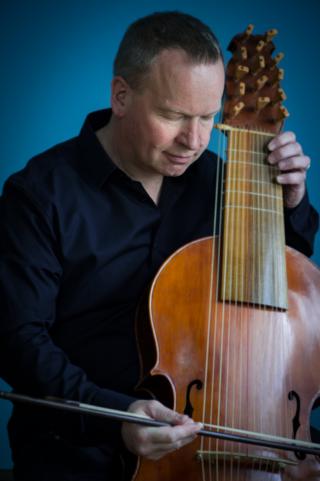De evangelist als verhaalverteller uit het verleden...
Langdurig verbleef Schütz twee keer in Noord-Italië. De eerste keer was hij er als student bij Giovanni Gabrieli in Venetië. Daarna reisde hij naar dezelfde regio om zangers en instrumentalisten te rekruteren voor het hof van Dresden. En ook gelijktijdig om partituren en instrumenten te kopen. De nieuwe oratoriumstijl had een grote invloed op Duitse protestanten.
De beroemde componisten van die tijd waren vooral zangers of virtuoze en veelzijdige instrumentalisten die de nieuwe stijl van basso continuo propageerden. Emilio de Cavallieri categoriseerde in zijn woord vooraf van „Rappresentatione di Anima et di Corpo“ uit 1600 twee soorten instrumenten. Enerzijds voor lange akkoorden het orgel en de lirone. Anderzijds voor getokkelde (dus korte) akkoorden het klavecimbel en de luit en chittarone. Giulio Caccini – de auteur van Le Nuove Musice uit 1601 - was een bekende tenor die zichzelf op luit en lira da gamba begeleide. Luzzano Luzzasci was componist en leraar. Terwijl hij het beroemde „Concerto delle donne“ repeteerde, kon hij drie zangeressen van Ferrara lesgeven, gebruik makend van zijn klavecimbel, dat 19 of 31 tonen per octaaf had. Zo leerden zij een perfecte intonatie terwijl zij zichzelf op harp, luit en gamba begeleiden. Claudio Monteverdi had bij het hof van Mantua gewerkt als een virtuoze viola bastarda speeler, lang voordat hij begon te componeren.
In renaissance Italië werd het idee van zelf-accompagnerende recitatie geboren. Als voorbeeld gold de Oud-Griekse uitvoeringspraktijk. De favoriete instrumenten waren toen lira da braccio en lira da gamba (lirone). Schütz componeerde zijn Evangelist in 'Auferstehungshistorie' volgens deze klankwereld van snaarinstrumenten omdat er geen lirone was in Saksen.
Oorspronkelijk werd de 'Historia von der fröhlichen und siegreichen Auferstehung' gecomponeerd in 1623 voor het Paasfeest in Dresden. Het werk werd gebruikt en gespeeld – vele dagen aanhoudend - als religieuze muziek aan het hof van de prins (alsof wij naar een nieuwe CD telkens weer luisteren en de muziek leren). Het is terecht om dit stuk in kleine kring te spelen, want die past niet in grote kerkgebouwen.
In het centrum van de uitvoering vindt men de Evangelist en zijn verhaal geaccompagneerd door drijvende en trillende geluiden. Er zijn ook delen van dit stuk die door een vocaal ensemble van 12 zangers (4 Sopranen 2 Alten, 4 Tenoren, 2 Bassen) worden gezongen. Voor de begeleiding gebruikt men bij voorkeur een klein orgel of een chitarrone.
Het volgende artikel over alle uitvoeringsaspecten van 'Auferstehungshistorie' werd als les gegeven en daarop gepubliceerd in 2002. „Beiträgen zur musikalischen Quellenforschung, Band 5“, Heinrich-Schütz-Hauses, Bad Köstritz nagedrukt in Mitteilungen Nr.49, Viola da Gamba Gesellschaft.
Jij kunt het .pdf-bestand hier downloaden:

